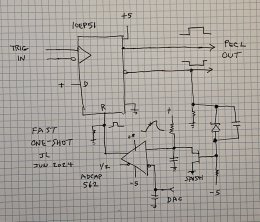Post by john larkinOn Wed, 12 Jun 2024 17:22:49 -0000 (UTC), Cursitor Doom
Post by john larkinPost by john larkinHere's another idea for a fast one-shot. This is the just-apply-money
version and should get close to 1 ns pulse width and should easily
trigger at 150 MHz.
https://www.dropbox.com/scl/fi/1okfo8964bw5m53mjmxs6/
Pecl_One_Shot_1.jpg?rlkey=dwus6qjyqsynl2rv6uje2xxtj&raw=1
Post by john larkinI can use the other half of the dual comparator elsewhere. This one has
programmable hysteresis too.
Exposing my contemptworthy ignorance here no doubt, but what exactly is it
that is fast about this design, John? And what would its application be?
It would have a leading-edge prop delay of 350 ps, a minimum pulse
width just over 1 ns, and would easily trigger at 150 MHz. Integrated
one-shots, xxx123 types, are always terrible, even the obsolete ECL
ones.
It would be a programmable delay in a number of possible products,
including some optical modulators. Just playing right now.
More dollars could certainly do something faster, but as long as
customers connect boxes with cables, faster isn't worth a lot. Light
just moves too slow.
Any suggestions for a faster one-shot?
Version 4
SHEET 1 2924 1040
WIRE -592 -720 -768 -720
WIRE 128 -720 -592 -720
WIRE 304 -720 128 -720
WIRE 768 -720 304 -720
WIRE 976 -720 768 -720
WIRE 1488 -576 1488 -720
WIRE 128 -560 128 -720
WIRE 304 -560 304 -720
WIRE 768 -560 768 -720
WIRE -592 -384 -592 -720
WIRE 1072 -368 1072 -400
WIRE 768 -320 768 -480
WIRE 960 -320 768 -320
WIRE 1008 -320 960 -320
WIRE 128 -288 128 -480
WIRE 176 -288 128 -288
WIRE 576 -288 240 -288
WIRE 768 -208 768 -320
WIRE 304 -160 304 -480
WIRE 400 -160 304 -160
WIRE 576 -160 576 -288
WIRE 576 -160 480 -160
WIRE 640 -160 576 -160
WIRE 704 -160 640 -160
WIRE -768 -64 -768 -720
WIRE 128 48 128 -288
WIRE -272 96 -432 96
WIRE 64 96 -192 96
WIRE 640 128 640 -160
WIRE 304 160 304 -160
WIRE -432 240 -432 96
WIRE -768 416 -768 16
WIRE -768 416 -880 416
WIRE -736 416 -768 416
WIRE -592 416 -592 -320
WIRE -592 416 -736 416
WIRE -496 416 -592 416
WIRE -432 416 -432 320
WIRE -432 416 -496 416
WIRE 640 416 640 208
WIRE 640 416 -432 416
WIRE 1072 416 640 416
WIRE 128 464 128 144
WIRE 768 464 768 -112
WIRE 768 464 128 464
WIRE -880 496 -880 416
WIRE 768 496 768 464
WIRE -736 640 -736 416
WIRE -496 640 -496 416
WIRE -736 656 -736 640
WIRE -736 944 -736 720
WIRE -496 944 -496 704
WIRE -496 944 -736 944
WIRE 304 944 304 240
WIRE 304 944 -496 944
WIRE 768 944 768 576
WIRE 768 944 304 944
WIRE 1760 944 768 944
FLAG -880 496 0
FLAG 960 -320 out
SYMBOL npn 64 48 R0
SYMATTR InstName Q1
SYMATTR Value BFR92A
SYMBOL npn 704 -208 R0
SYMATTR InstName Q2
SYMATTR Value BFR92A
SYMBOL voltage -768 -80 R0
WINDOW 123 0 0 Left 0
WINDOW 39 24 44 Left 2
SYMATTR SpiceLine Rser=0.1
SYMATTR InstName V1
SYMATTR Value 5.0
SYMBOL voltage -736 624 R0
WINDOW 123 0 0 Left 0
WINDOW 39 24 44 Left 2
SYMATTR SpiceLine Rser=0.1
SYMATTR InstName V2
SYMATTR Value 4.5
SYMBOL voltage -432 224 R0
WINDOW 123 0 0 Left 0
WINDOW 39 0 0 Left 0
SYMATTR InstName V3
SYMATTR Value PULSE(0 0.2 1n 300p 300p 100p 200n 2)
SYMBOL res -176 80 R90
WINDOW 0 0 56 VBottom 2
WINDOW 3 32 56 VTop 2
SYMATTR InstName R1
SYMATTR Value 22
SYMBOL res 752 480 R0
SYMATTR InstName R3
SYMATTR Value 360
SYMBOL res 112 -576 R0
SYMATTR InstName R4
SYMATTR Value 180
SYMBOL res 624 112 R0
SYMATTR InstName R5
SYMATTR Value 43
SYMBOL res 752 -576 R0
SYMATTR InstName R6
SYMATTR Value 180
SYMBOL res 288 -576 R0
SYMATTR InstName R2
SYMATTR Value 1k
SYMBOL cap 240 -304 R90
WINDOW 0 0 32 VBottom 2
WINDOW 3 32 32 VTop 2
SYMATTR InstName C1
SYMATTR Value 3.3p
SYMBOL res 288 144 R0
SYMATTR InstName R7
SYMATTR Value 1k2
SYMBOL res 496 -176 R90
WINDOW 0 0 56 VBottom 2
WINDOW 3 32 56 VTop 2
SYMATTR InstName R13
SYMATTR Value 43
SYMBOL cap -608 -384 R0
SYMATTR InstName C3
SYMATTR Value 10n
SYMBOL cap -512 640 R0
SYMATTR InstName C4
SYMATTR Value 10n
TEXT -272 1000 Left 2 !.model BFR92A NPN(IS=0.1213E-15 VAF=30 BF=94.73
IKF=0.46227 XTB=0 BR=10.729 CJC=946.47E-15 CJE=10.416E-15 TR=1.2744E-9
TF=26.796E-12 ITF=0.0044601 VTF=0.32861 XTF=0.3817 RB=14.998
RC=0.13793 RE=0.29088 Vceo=15 Icrating=4m mfg=Infineon)
TEXT -904 1024 Left 2 !.tran 0 500n 0
It's just a two transistor emitter-coupled monostable, but with the two
transistors as BFR92's run at 10mA, it produces 1nsec pulse without fuss.
Finding the broad-band PNPs to let you translate the output pulse to a
useful voltage level is tricky. Phil Hobbs has told us that there is a
least one still in production and available.
--
Bill Sloman, Sydney
--
This email has been checked for viruses by Norton antivirus software.
www.norton.com
